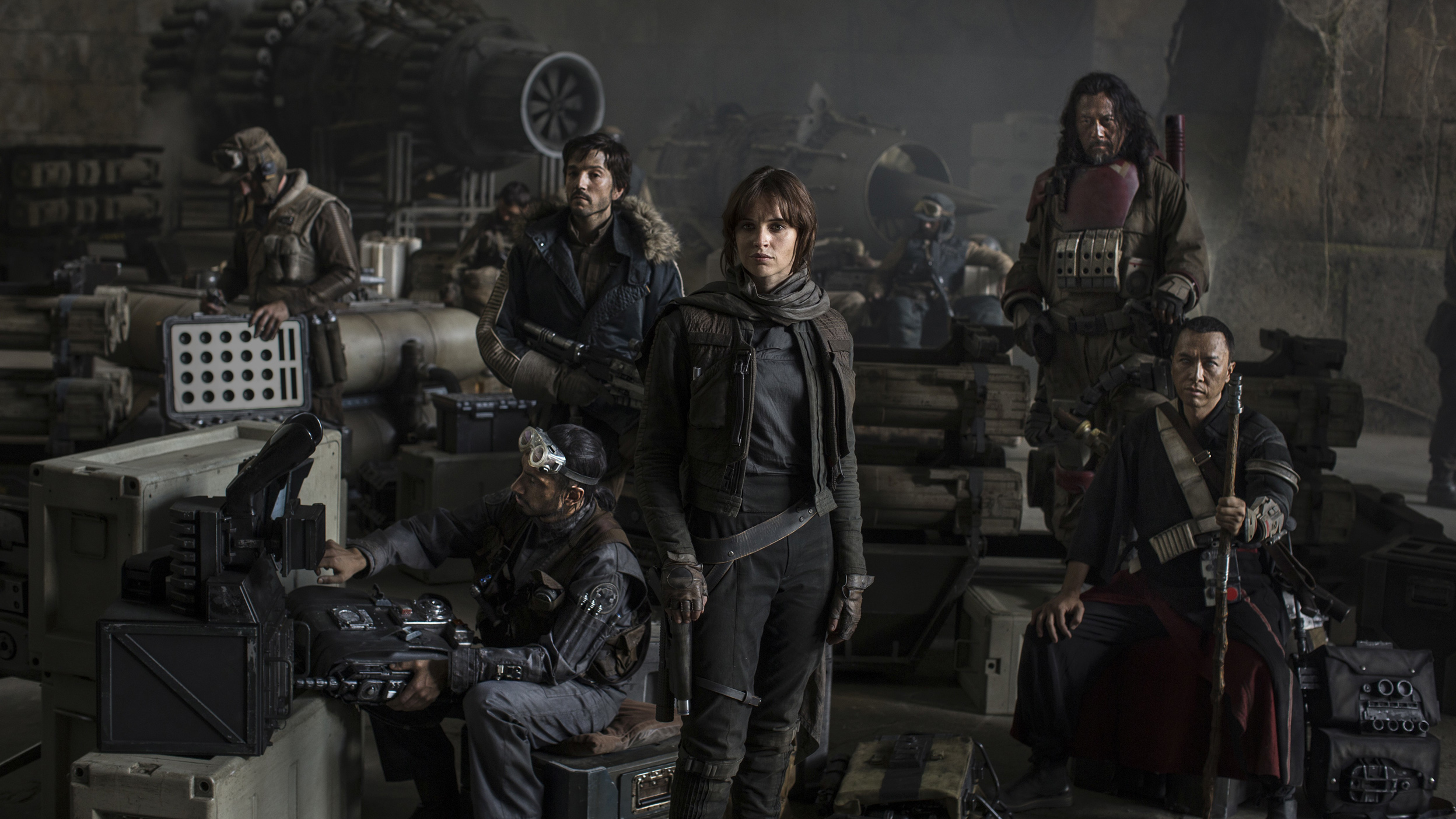The predetermination around a franchise film’s storyline means it necessarily has to color within some pretty predictable lines. Gareth Edwards’s Rogue One: A Star Wars Story intends to set his standalone film apart within the Star Wars universe’s “episodes” by painting with violent, desperate strokes and unexpected hues. The intentions are sound, but the mixed bag that results often feels less like the Force is with it and more like many hands were forced to operate on it.
From eschewing the iconic “opening crawl” to circumventing the arcs of Skywalkers, Jedi, and intergalactic royalty that have defined this universe in previous installments, Edwards and screenwriters Chris Weitz and Tony Gilroy try to explore the narrative potential of these various outer worlds by bending the pre-established rules. It’s an opportunity that allows for different visual and tonal flourishes than what have come before, but just as Rogue One begins to establish its own distinct identity, it gets weighed back down by the gravity of expectations, icons, and allusions to the events that technically lie ahead in the larger timeline of these films.
Set between the events of Episode III: Revenge of the Sith and Episode IV: A New Hope, Rogue One follows Jyn Erso (Felicity Jones), the daughter of the Death Star’s reluctant chief architect, Galen (Mads Mikkelsen). Jyn joins with Cassian Andor (Diego Luna), a Rebel with more cause than sense, in the hopes that the Rebellion’s fight will lead her back to her father. She’s unaware that Andor intends to assassinate Galen in the hopes of…well, that’s a bit murky, since the Death Star is built already (and frankly pretty hard to miss), but Luna gamely sells the exhaustion and smolder of someone who’ll do anything to finally stop fighting. Along the way, they collect a Dirty Half-Dozen of outlaws and misfits who share disdain for the evil Empire and are anti-establishment enough to fight when conditions change and the opportunity to steal the blueprints for the Death Star arises.
At times Rogue One feels less operatic than the rest of the franchise. The warfare feels guerilla, messy, and unusually personal. An opening that establishes Jyn’s backstory rings like a beautiful Western pastiche of tall grass and tense Sergio Leone (or maybe Quentin Tarantino doing Sergio Leone) stand-offs, and the knack Edwards showed for establishing frightening scale in Monsters and Godzilla gives the Death Star and AT-AT Walkers some real intimidation. But the high pop drama and popcorn vibrancy of the other Star Wars films also made them upbeat and fun; while those movies ran on adrenaline, Rogue One runs on anxiety. On the one hand, it makes many long sequences feel leaden and uncertain. But alternately, Edwards has built a true curiosity: a Star Wars film shadowed by the presence of death. For the first time in this universe, one truly feels like any of these new characters could die at any moment—and, in fact, that they probably must.
Edwards has built a true curiosity: a Star Wars film shadowed by the presence of death.
The fatal stakes and impending Imperial doom are among the more successful of Edwards’s achievements within his given confines, along with the frightening beta-test version of the Death Star and the very successful movement to Make Darth Vader Scary Again. Less successful are attempts to push a comic relief robot who’s an even sassier buzzkill than C-3PO and a ghoulish, distracting effort to revive deceased actor Peter Cushing as Grand Moff Tarkin through a CGI recreation that fails in both intention and execution.
For all its imperfections, the biggest silver lining to this star cloud is its diverse and colorful cast. For decades, the Star Wars universe featured approximately one black man and one black man’s disembodied voice; now, these worlds have as many types of humans as they do droids and rubber-masked aliens, to the benefit of the global audience eagerly anticipating them. Diego Luna and Riz Ahmed are compelling and urgent, perhaps most so when they aren’t trying to sell expository dialogue. Oscar winner Forest Whitaker brings deep world-weariness to a Rebel warrior whose bionic body and unnatural breathing echoes Lord Vader in a thought-provoking but unpursued parallel. And best of all, the duo of Donnie Yen’s blind monk Chirrut and Wen Jiang’s armored bodyguard Baze finally bring a substantial, memorable Asian presence to a film series that was influenced generations ago by George Lucas’s love of Akira Kurosawa films like Hidden Fortress. Toshiro Mifune would be proud of these MVPs; Yen and Jiang bring airs of the mysterious, the unspoken, and the sacred back to the mythology of the Force with their mix of blue-collar grit and philosopher’s grace.
What a diverse cross-section of humanity in an off-world blockbuster franchise will contribute to tomorrow’s culture we can only guess at today. But as young audiences get inspired by seeing themselves reflected and represented on screen, it will make for some great entertainment to watch many of these fans grow from inspired consumers to conscientious creators in a reality not so far, far away. FL









